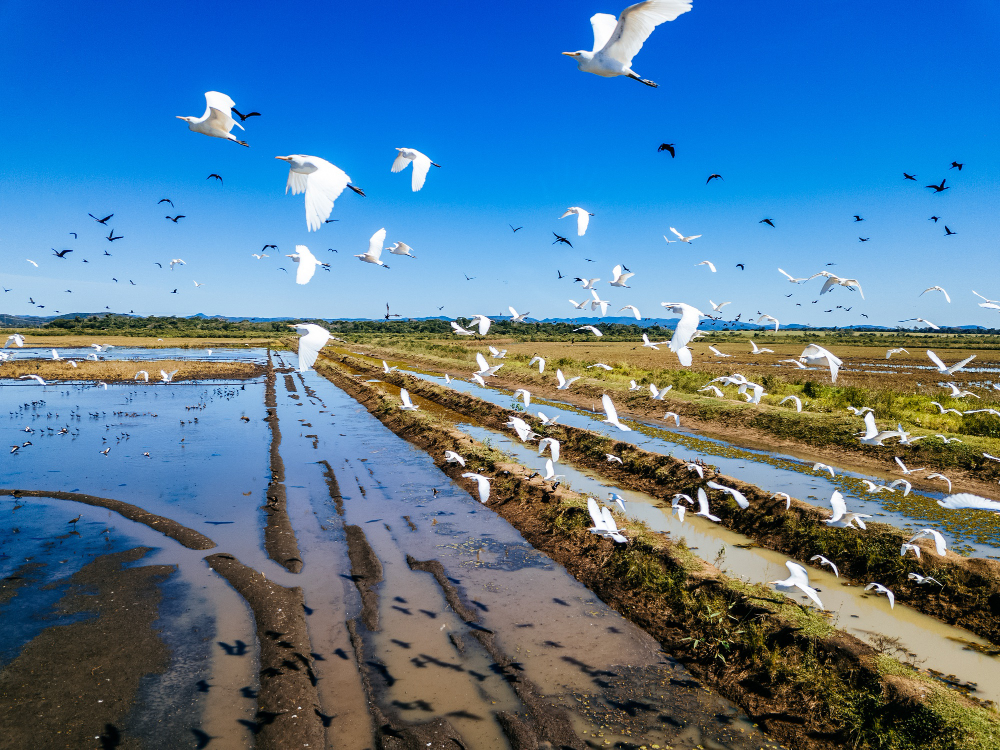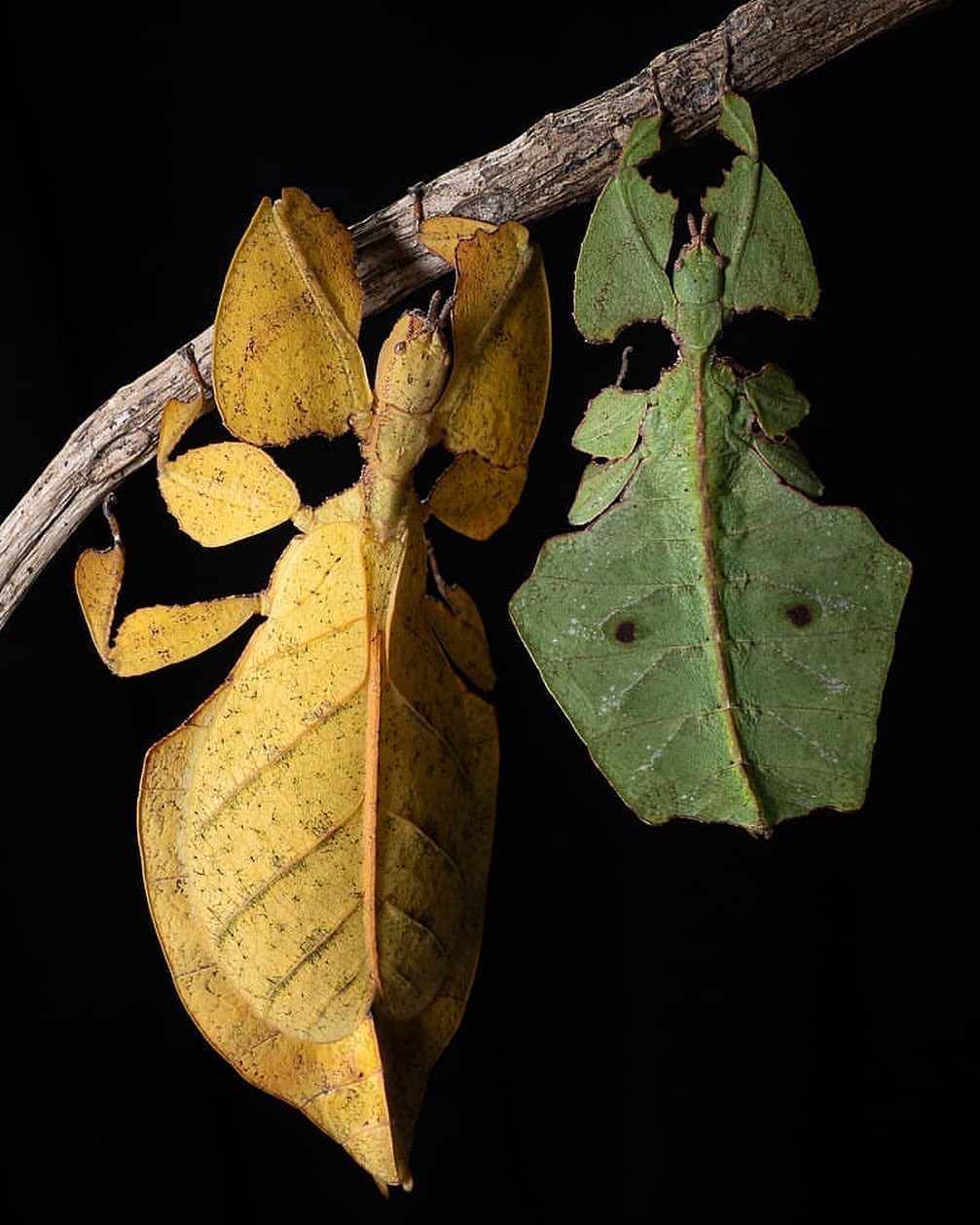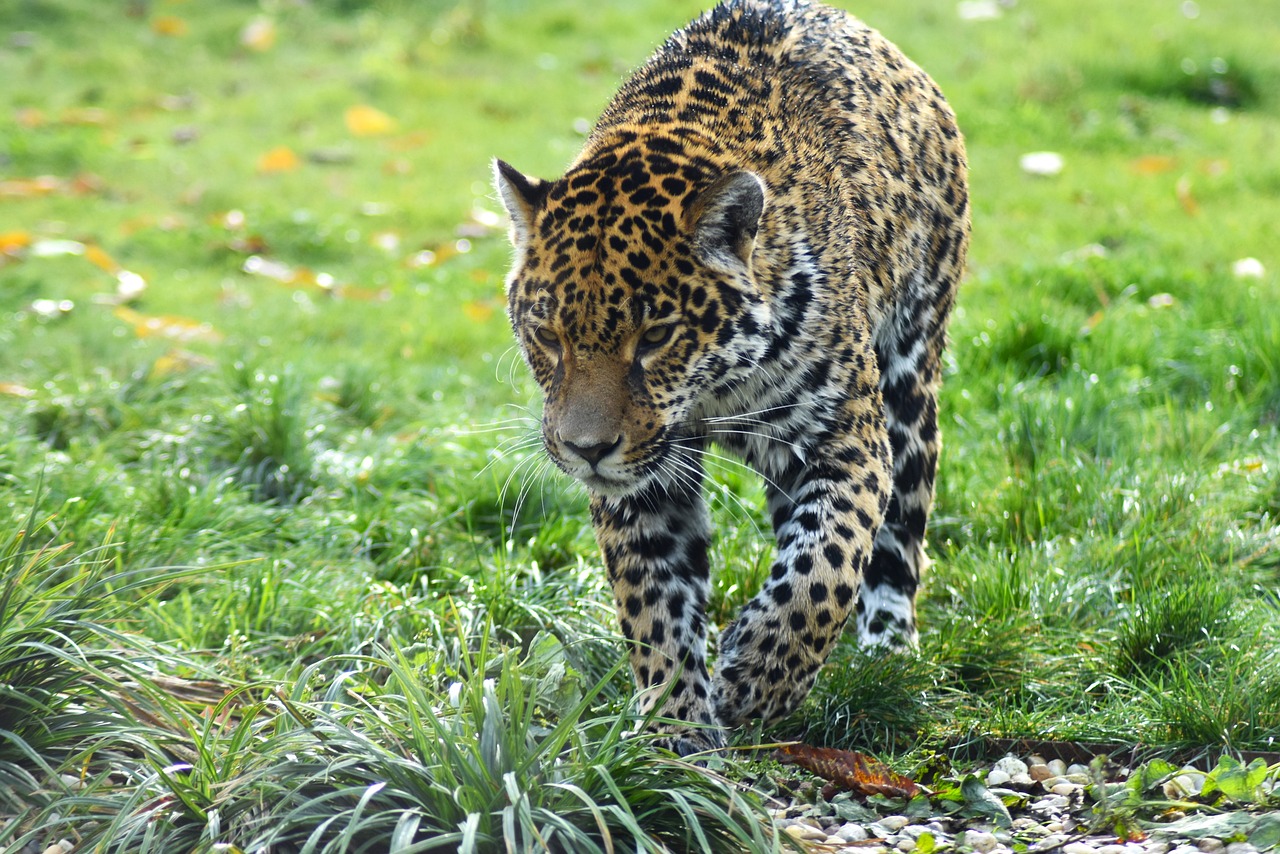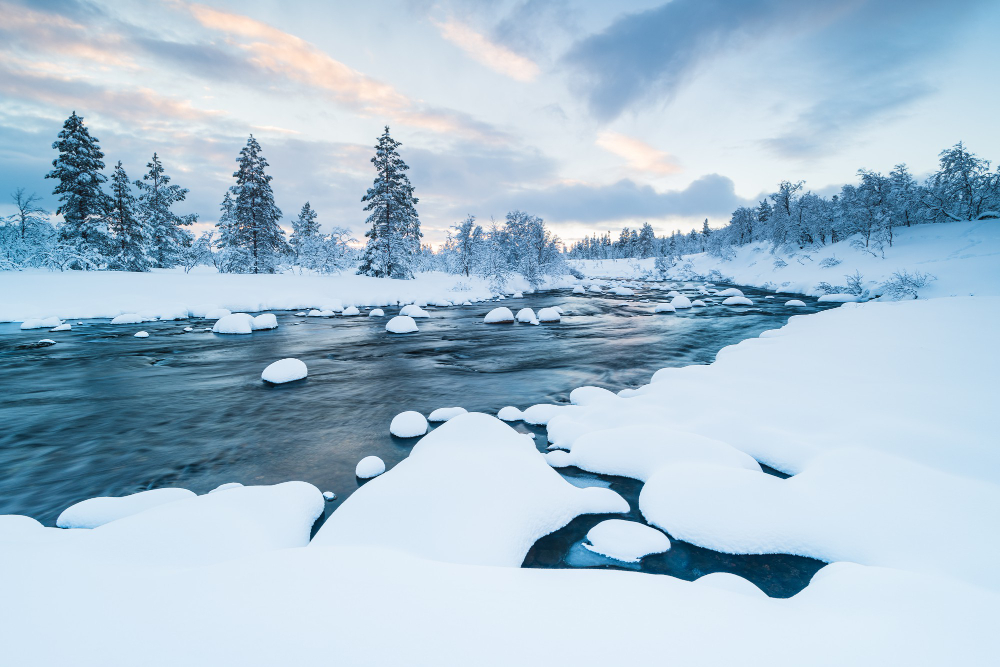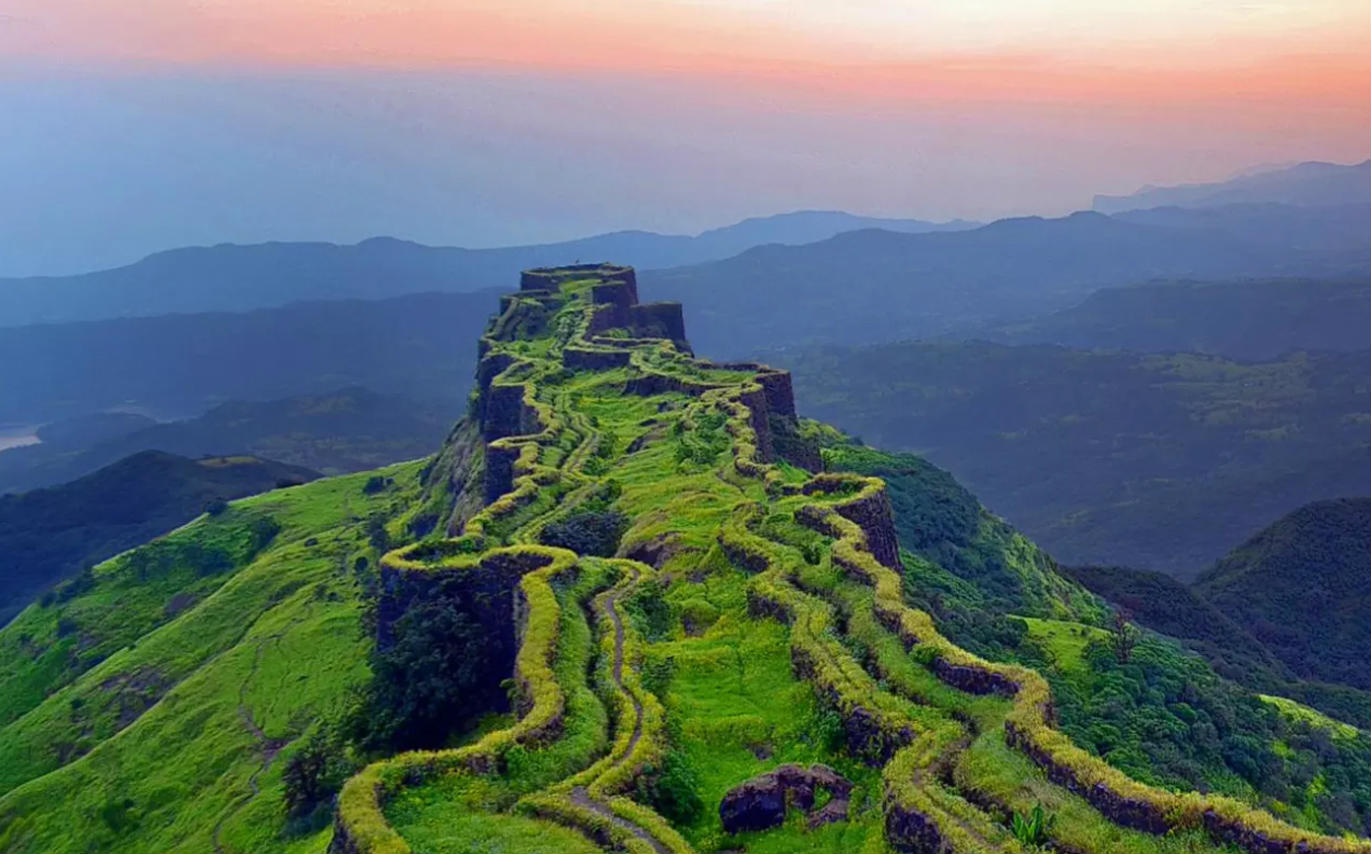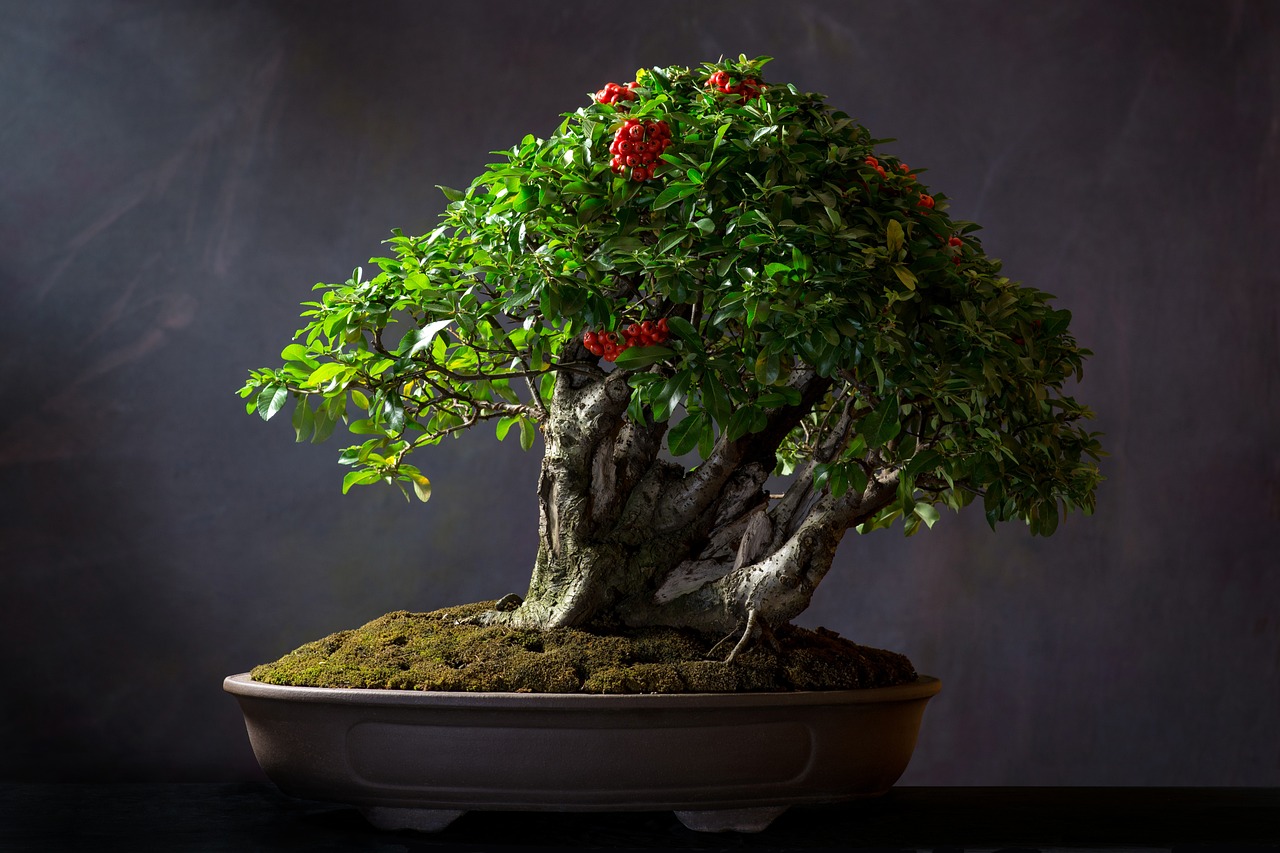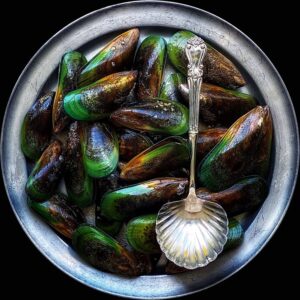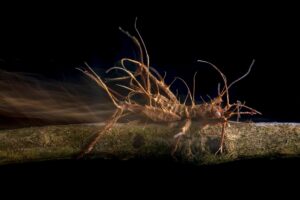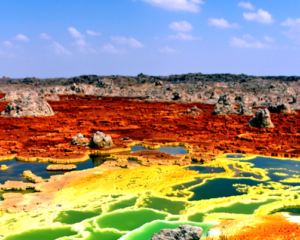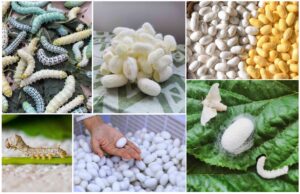 Pin
Pin Photo sources: Internet
Fruit doesn’t always come wrapped in predictable packages. Sometimes it arrives wearing armor made of dragon scales. Other times it dangles from trees like forgotten dreams, sticky with honey and whispers of places your passport has never touched.
The earth keeps secrets in its tropical corners. While supermarkets parade the same circular oranges and crescent bananas, forests across Indonesia, Southeast Asia, and the Pacific islands guard fruits that seem pulled from a fever dream. These aren’t gentle, polite fruits. They’re aggressive with flavor, shocking in appearance, and utterly indifferent to your expectations. Some smell like garbage dumps but taste like heaven.
Others look lethal but melt on your tongue like silk. A few have been growing in the same villages for thousands of years, feeding families who never thought to Instagram them or ship them overseas. We’re about to meet twenty of these botanical rebels, arranged from the rarest whispers of existence to the ones that have started making noise in the wider world. Each one bends the rules about what fruit should look, taste, or smell like.
Table of Contents
1. Indonesian Wild Coconut
 Pin
Pin Photo by Silverdisobedience
The Indonesian wild coconut exists in such remote pockets of rainforest that most botanists have only read about it in fading research papers. This isn’t the coconut you crack open on vacation. It grows smaller, harder, with a shell that could stop a machete. The flesh inside tastes sharper, more fermented, like the forest decided to age regular coconut in oak barrels filled with moss and rain. Local communities in isolated Indonesian islands still harvest these ancient relatives of the common coconut, but they’re disappearing as forests shrink and younger generations forget which trees their grandparents climbed.
What makes this fruit melt into obscurity is its stubborn refusal to grow anywhere civilized. It demands specific soil, specific rainfall patterns, and trees that have stood untouched for decades. You can’t farm it. You can’t mass-produce it. The Indonesian wild coconut grows on its own terms or not at all, which means tasting one requires either tremendous luck or a willingness to trek through jungle that hasn’t seen a footpath in years. The water inside runs cloudy and thick, nothing like the clear liquid tourists sip through straws. It’s funkier, earthier, tasting of the ground it grew from rather than some sanitized tropical paradise fantasy.
2. Nipa Palm Fruit
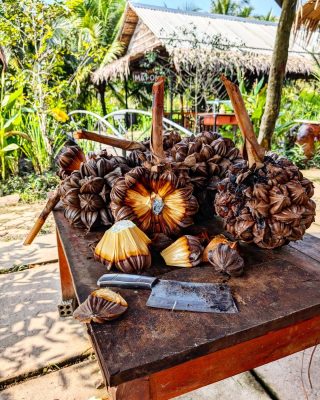 Pin
Pin Photo by Mara
The nipa palm fruit hangs in clusters that look like geometric hallucinations, each segment fitting together like nature attempted architecture. These fruits grow where land dissolves into water, in mangrove swamps and tidal zones where most plants would drown. The palm itself rises from brackish mud, neither fully land-based nor aquatic, existing in that liquid boundary where ecosystems blur. Inside each hard brown segment hides translucent jelly that wobbles like captured moonlight.
People throughout coastal Southeast Asia have chewed this jelly for centuries, mixing it into desserts or eating it plain with a sprinkle of sugar to cut the mild, cucumber-like flavor.
Finding nipa palm fruit means wading into places where the ground shifts beneath your feet and crabs scuttle sideways through the roots. The palms thrive in conditions that would kill conventional fruit trees, their roots breathing through saltwater and their fronds catching ocean breezes that taste of fish and storms. What keeps this fruit rare isn’t just its habitat but the effort required to harvest it. You can’t roll a truck up to a nipa palm. You arrive by boat, machete in hand, timing your visit with the tides. The jelly inside spoils quickly once exposed to air, which means it rarely travels far from where it grew. Most of the world will never taste it simply because it refuses to leave home.
3. Soursop
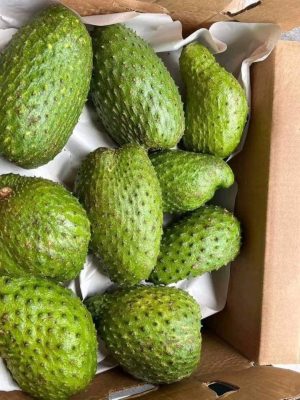 Pin
Pin Photo by Patriqué Dé Bravo
Soursop wears its strangeness on the outside like a confession. The green skin bristles with soft spines that bend under your thumb, giving the whole fruit the texture of a cactus that lost its nerve. Beneath that defensive exterior lies white flesh so creamy it could pass for custard if custard grew on trees and tasted like pineapples arguing with strawberries while vanilla tried to mediate. The flavor hits your tongue in waves, each one slightly different from the last, sweet then tart then inexplicably floral.
People across the Caribbean and Central America have built entire dessert traditions around this fruit, blending it into drinks, freezing it into ice cream, or simply scooping it straight from the shell with a spoon.
The soursop tree doesn’t demand much attention, which partly explains why it grows in backyards rather than commercial orchards. It likes warmth and humidity but tolerates neglect better than most fruit trees. What keeps soursop relatively unknown outside tropical regions is its terrible travel etiquette. The fruit bruises if you look at it wrong, turning from perfect to rotten in the span of a day once picked. Shipping it requires the kind of careful handling that makes it financially ridiculous for most exporters. So it stays local, sold in markets where vendors know to cushion each one like a fragile thought, where customers buy them slightly underripe and wait at home for that perfect moment of soft, fragrant ripeness.
4. Mokambo
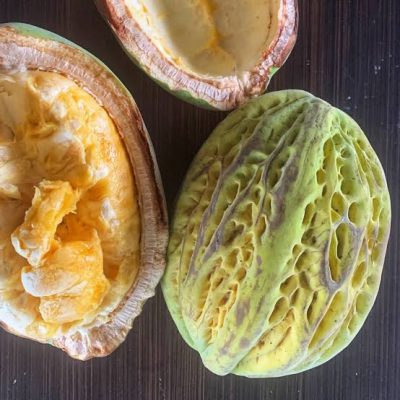 Pin
Pin Photo source: Facebook
Mokambo dangles from trees in the Amazon basin like oversized green hand grenades, each one heavy enough to knock sense into anyone standing below. The pods grow up to a foot long, their thick rinds protecting seeds wrapped in white pulp that tastes bizarrely of chocolate and citrus having a midnight conversation. Indigenous communities in Colombia, Ecuador, and Peru have known this fruit for generations, cracking open the pods to suck the pulp off seeds that they’d later plant or roast. The flavor doesn’t announce itself politely. It rushes in with cocoa intensity, then pivots sideways into tropical fruit territory, leaving your taste buds genuinely confused about what just happened.
This fruit’s rarity stems from pure geographical stubbornness. Mokambo trees only thrive in specific pockets of rainforest where rainfall and soil chemistry align just right. Attempts to cultivate it elsewhere generally fail because the tree simply refuses to cooperate outside its ancestral home. The pulp oxidizes quickly after the pod opens, turning from white to brown in minutes, which makes commercial distribution nearly impossible without processing it immediately. Most people who taste mokambo do so standing under the tree it fell from, or at a local market where vendors sell the pods within hours of harvest. The seeds themselves contain compounds being studied for potential health benefits, but the fruit remains largely a secret kept by the forest and the people who still live close enough to hear it.
5. Casabanana
 Pin
Pin Photo by miamifruit.org
Casabanana stretches across vines like a fever dream of what a melon might become if it decided to grow up instead of out. These fruits can reach two feet long, their waxy red-orange skin gleaming in the sun like polished leather. The smell hits you before you even cut into one—a perfume so intense it fills entire rooms, somewhere between cantaloupe and rose petals with a hint of something unnameable. Inside, the orange flesh surrounds a hollow cavity filled with seeds suspended in jelly, the whole arrangement looking less like food and more like botanical origami. People in Central and South America use casabanana more for its fragrance than its flavor, tucking whole fruits into closets and drawers where they release their scent for months.
The taste itself walks a strange line between squash and melon, neither sweet enough to eat raw with enthusiasm nor savory enough to cook without help. Most folks who grow casabanana end up candying it, pickling it, or turning it into jam where sugar can amplify its subtle charms. The vines climb with aggressive enthusiasm, taking over fences and trellises, producing these elongated fruits that look like they’re trying to escape their own skin. What keeps casabanana rare is simple lack of demand. Modern markets want fruits that taste obviously delicious straight from the hand. Casabanana requires imagination, effort, and a tolerance for strange perfumes lingering in your kitchen for weeks after you’ve finished cooking with it.
6. Jackfruit
 Pin
Pin Photo by enebro.exoticas
Jackfruit doesn’t apologize for taking up space. These fruits swell to grotesque proportions on tree trunks, sometimes weighing eighty pounds or more, their bumpy green skin stretched tight over flesh that could feed a family for days. The exterior feels like dinosaur hide, covered in blunt hexagonal spikes that won’t hurt you but make the whole thing look vaguely threatening. Cutting into a jackfruit requires commitment—a sharp knife, muscle, and patience as you work through layers of latex-sticky flesh to reach the golden pods inside. Each pod tastes like fruit salad decided to become a single entity, with notes of banana, pineapple, and mango swirled together in a chewy, fibrous package that pulls apart like tender meat.
Southeast Asia has cultivated jackfruit for thousands of years, and lately the rest of the world has started paying attention. Vegetarians discovered that young, unripe jackfruit shreds like pulled pork and absorbs flavors with impressive enthusiasm. Ripe jackfruit, though, tells a completely different story—intensely sweet, almost cloying, with a scent that divides people into passionate lovers and equally passionate haters. The smell seeps into your hands, your clothes, your cutting board, lingering like a houseguest who doesn’t understand hints. Despite growing abundantly in tropical regions, jackfruit’s massive size and challenging preparation keep it from dominating global markets. You need dedication to wrestle with a jackfruit, which means casual fruit shoppers usually walk past it toward something less intimidating.
7. Pineapple
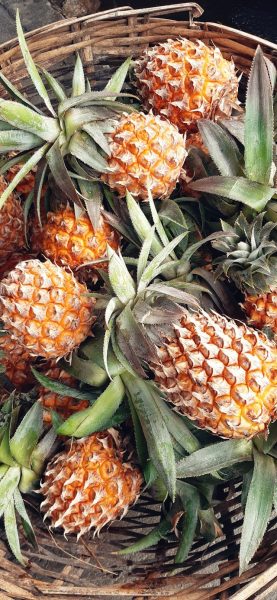 Pin
Pin Photo by Oumar Ramjean
Pineapples sit in an odd position on this list because everyone knows them, yet almost nobody understands how truly bizarre they are. This fruit doesn’t grow on trees or bushes. It emerges from the center of a spiky plant that looks like it’s assembled from sword blades, the fruit pushing upward through a crown of leaves like a botanical middle finger. Each pineapple is actually a fusion of many smaller fruits that merged together, which explains those hexagonal segments covering the surface. The plant takes nearly two years to produce a single fruit, pouring all its energy into one golden, fragrant cylinder before dying back. Wild pineapples still grow in parts of South America, smaller and more acidic than the cultivated varieties, their flesh sharp enough to make your mouth sting.
What makes pineapples unique isn’t their global availability now, but rather how recently they achieved that status. Just two centuries ago, pineapples were so rare in Europe and North America that wealthy families would rent them for parties as centerpiece decorations, returning them uneaten because they cost more than houses. The fruit contains bromelain, an enzyme that actively digests protein, which means pineapples are literally trying to eat you back while you eat them. That’s why your tongue tingles after too much fresh pineapple. The commercial pineapple industry has bred much of the wildness out of modern varieties, making them sweeter and less aggressive, but you can still taste the original ferocity in every bite if you pay attention to that acidic backbone running through the sweetness.
8. Durian
 Pin
Pin Photo by the electric garderner
Durian arrives in your life like an olfactory assault wrapped in medieval weaponry. The shell bristles with sharp pyramidal spikes that could puncture skin if you’re careless, and the smell that leaks from ripe durian has been compared to sewage, rotting onions, turpentine, and gym socks left in a hot car for weeks. Hotels across Southeast Asia ban durian from their premises. Airlines refuse to transport it. Signs in public transit systems feature the fruit crossed out in red, as if it were a weapon or contraband. Yet millions of people consider durian the king of fruits, worth every bit of social awkwardness its presence creates.
The custardy yellow flesh inside tastes of caramelized onions blended with vanilla cream and almond, a flavor so rich and complex it seems impossible that it could emerge from something smelling like a crime scene.
The durian’s reputation precedes it so dramatically that many people never get past the smell to experience the taste. Those who do often become obsessed, traveling to specific orchards for particular varieties, debating the merits of different regional cultivars with the intensity wine snobs bring to vineyards. The fruit grows throughout Southeast Asia, particularly Thailand, Malaysia, and Indonesia, where entire festivals celebrate the harvest season. Durian trees can live for a century and grow over a hundred feet tall, dropping their heavy, spiked fruits without warning. People have died from durian impact, which adds a element of danger to the whole experience. What keeps durian from true global domination isn’t availability but rather that smell, which acts as a biological filter separating the adventurous from the cautious.
9. Bambangan
 Pin
Pin Photo by Simon & Tina
Bambangan grows wild in the forests of Borneo, a fruit so obscure that even many Malaysians from other regions have never encountered it. The oval fruits dangle from tall trees, their skin ripening from green to brown with a texture like rough leather. What sets bambangan apart is the shocking sourness that hits your mouth when you bite into the flesh—a tartness so intense it makes lemons seem timid by comparison. The locals don’t eat it raw unless they’re exceptionally brave or nostalgic. Instead, they slice it thin and pickle it with salt and chilies, transforming that aggressive acidity into something savory and addictive.
The fermented version, called jaruk, becomes a condiment that appears at nearly every meal in Kadazan-Dusun communities, cutting through the richness of rice and meat with its bright, funky punch.
The bambangan tree produces fruit erratically, sometimes heavy with harvest, other years offering almost nothing. This unpredictability makes commercial cultivation impractical, so the fruit remains tied to wild trees and traditional knowledge about when and where to find them. The flesh oxidizes quickly after cutting, turning from pale yellow to dark brown within minutes, which means preservation techniques become essential rather than optional. Beyond the pickled preparations, some families extract oil from bambangan seeds, using it for cooking or traditional medicine. The fruit’s extreme rarity outside Borneo stems from its refusal to travel well and the simple fact that industrial agriculture has never figured out how to tame it. Bambangan belongs to the forest and to the people who’ve always known how to turn its fierce sourness into something worth keeping in clay jars for months.
10. Banana
 Pin
Pin Image by Djero from Pixabay
Bananas occupy such familiar territory in our fruit bowls that we forget how genuinely strange they are. The banana you peel for breakfast is a genetic oddity, a sterile mutant that can’t reproduce through seeds. Every commercial banana is a clone, cut from the same plant and replanted, which means the Cavendish banana you ate yesterday is genetically identical to every other Cavendish growing worldwide. Wild bananas still exist in Southeast Asian forests, but they’re packed with hard black seeds that make eating them an exercise in frustration. Ancient farmers selectively bred those seeds away over thousands of years, creating the seedless yellow crescents we know today. The plants themselves aren’t even trees despite their tree-like appearance—they’re giant herbs, the largest plants on earth without woody stems, their trunks built from tightly wrapped leaf sheaths that can grow twenty feet tall.
The banana’s journey from exotic luxury to mundane staple happened remarkably fast. A century ago, different banana varieties dominated markets—the Gros Michel, which reportedly tasted richer and creamier than modern bananas. Then a fungus wiped out nearly every Gros Michel plantation worldwide, and the industry pivoted to the Cavendish because it resisted that particular disease. Now the Cavendish faces its own fungal threat, and scientists worry we might lose our most common banana within decades. What makes bananas unique isn’t just their biological peculiarity but the precarious genetic uniformity that keeps them affordable and available. We’re eating a fruit that technically shouldn’t exist, grown on plants that aren’t really trees, living one disease outbreak away from potential extinction. The ordinariness of bananas masks how extraordinary and vulnerable they actually are.
11. Red Palm Fruit
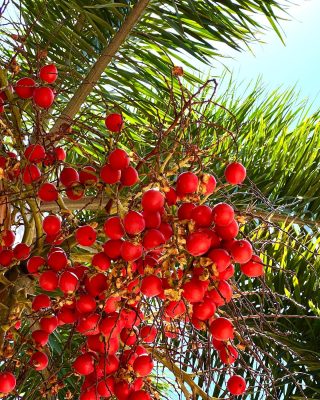 Pin
Pin Photo by Douglas Galloway
Red palm fruit clusters hang from oil palms like bunches of oversized dates dipped in rust-colored wax. Each fruit is small—about the size of a plum—but packed so densely on the stem that harvesting them means cutting down entire bunches that can weigh forty pounds or more. The outer flesh contains more beta-carotene than carrots, which gives it that deep orange-red color and explains why palm oil extracted from these fruits glows like liquid sunset.
Chewing the fibrous flesh raw delivers an oily, slightly sweet taste with earthy undertones, though most people never experience red palm fruit in its whole form. Instead, they consume it as palm oil, which has infiltrated roughly half of all packaged products in supermarkets, from cookies to shampoo, usually without anyone realizing these bright fruits were involved.
West and Central African cuisines have centered around red palm fruit for millennia, cooking the whole fruits into rich stews where the oil separates and colors everything a vivid orange. The fruits must be boiled or steamed to soften them enough to extract the oil, and traditional processing involves pounding the cooked fruits in large mortars, then separating the oil from the fibrous mash through a series of washing and skimming steps. Industrial palm oil production has made these fruits economically significant but ecologically controversial, as vast plantations replace rainforests across Southeast Asia and Africa. The fruit itself remains mostly unknown to people who consume its oil daily, creating a strange disconnect between the bright, oily drupes growing in tropical heat and the anonymous ingredient listings on products shipped worldwide.
12. Long-necked Avocado
 Pin
Pin Photo by Fresh Fruit Portal
The long-necked avocado stretches the concept of what an avocado should look like until it snaps into something entirely new. While standard avocados sit round and pear-shaped in your palm, these varieties elongate into bottles, gourds, or serpentine curves that can reach a foot in length. The neck tapers dramatically, sometimes twisting as it grows, giving each fruit a unique sculpture-like quality. Inside, the flesh maintains that characteristic avocado creaminess, though the flavor tends toward nuttier, less buttery territory than the Hass varieties dominating grocery stores. The seed runs proportionally longer too, a slim pit that fills much of that extended neck, which means you get less edible flesh per fruit than the shape suggests.
These elongated varieties grow primarily in parts of Central America, the Caribbean, and scattered locations across Southeast Asia where avocado cultivation went in experimental directions. Local markets sometimes feature them as curiosities, priced higher than regular avocados because of their unusual appearance despite offering less actual fruit. The trees produce inconsistently, and the fruits bruise easily during that long drop from branch to ground. What keeps long-necked avocados rare is mostly economics—when people want avocados, they want maximum flesh for their money, not architectural drama. Farmers have little incentive to cultivate varieties that look spectacular but deliver less food. Still, home gardeners and avocado enthusiasts seek out these elongated cultivars, planting them for the sheer pleasure of growing something that makes visitors stop and stare, trying to reconcile the familiar avocado flavor with a shape that belongs in a surrealist painting.
13. Toddy Palm
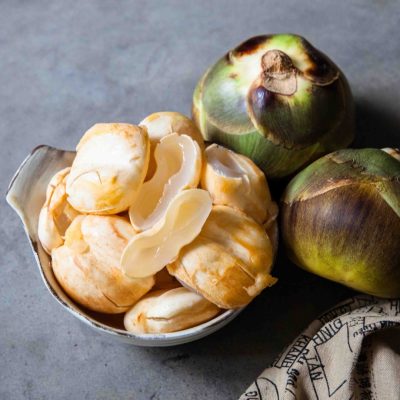 Pin
Pin Photo by May Ly
Toddy palm fruit emerges from trees that serve double duty as both food source and beverage factory. The fruits themselves grow in massive clusters beneath the palm’s crown, each one encased in a smooth, dark shell that requires cracking to reveal three ivory-colored kernels nestled inside like precious stones in a vault. These translucent kernels wobble with a jelly-like consistency, tasting mildly sweet with a refreshing quality similar to young coconut but with a firmer, more resilient texture. Across South and Southeast Asia, street vendors sell toddy palm kernels floating in syrup or coconut milk, often mixed with shaved ice to create desserts that locals have enjoyed for generations. The kernels must be harvested at precisely the right moment—too young and they lack substance, too old and they harden into inedible wood.
The toddy palm earned its name not from the fruit but from the sap that flows from cut flower stalks, which ferments naturally into an alcoholic beverage called toddy or palm wine. Tappers climb these palms twice daily to collect fresh sap, and this liquid gold has sustained communities for thousands of years, providing both nutrition and income. The fruit often gets overshadowed by the more lucrative sap business, which means many toddy palms never get the chance to produce their full fruit clusters. When fruits do mature, they provide a relatively brief harvest window before the kernels transform from tender jelly into hard, woody seeds. This timing challenge, combined with labor-intensive harvesting from tall palms, keeps toddy palm fruit relatively rare in global markets despite its popularity in regions where the trees grow abundantly.
14. Coconut Sprout
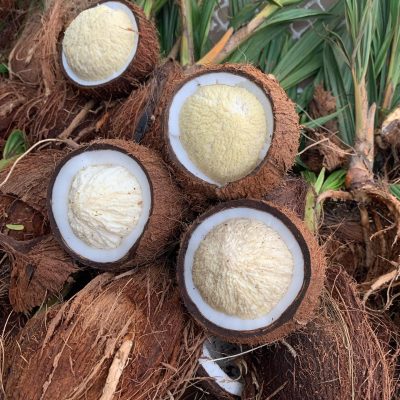 Pin
Pin Photo by Food and Nutrition
Coconut sprout exists in that strange moment when a coconut stops being a coconut and starts trying to become a tree. Inside mature coconuts left to their own devices, the water and flesh gradually transform into something unexpected—a spongy white ball that grows to fill the entire shell cavity. This ball, called the coconut apple or coconut embryo, has the texture of firm marshmallow and tastes subtly sweet with hints of the original coconut but milder, almost bland in its gentleness. You find coconut sprouts by listening for a different sound when you shake a coconut. Instead of liquid sloshing, you hear a soft thud as the solid sprout moves inside its chamber. Breaking open the shell reveals this peculiar transformation, the sprout sitting there like a secret the coconut kept while everyone assumed it was empty or spoiled.
Many cultures across the Pacific and Indian Ocean islands consider sprouted coconuts a delicacy, though they rarely appear in commercial trade because the timing makes them economically awkward. Coconuts become sprouts when they’re past their prime for normal consumption but not yet planted, occupying a narrow window that requires either luck or intentional neglect to achieve. Some people grate the sprout into desserts or eat it raw as a snack, appreciating its unique texture that’s unlike any other food. The sprout contains different nutrients than regular coconut, with more sugars concentrated from the conversion process. What keeps coconut sprouts rare is simply that commercial coconut operations have no interest in letting their inventory sit around long enough to sprout when they could sell it fresh. Finding one means either growing coconuts yourself or knowing a supplier willing to wait.
15. Screwpine
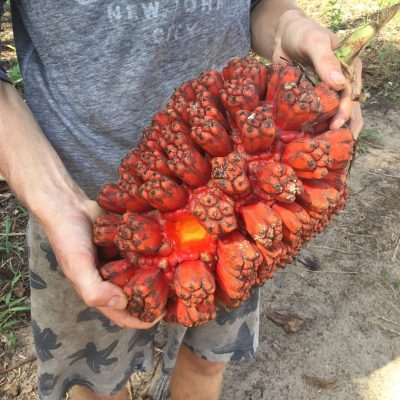 Pin
Pin Photo by Simon & Tina
Screwpine fruit looks like nature assembled a pineapple from spare parts and forgot the instruction manual. The fruit grows as a compound sphere made of dozens of wedge-shaped segments fitted together in geometric patterns, each segment tipped with a woody point. The whole thing can reach the size of a soccer ball, hanging from pandanus trees that grow along coastlines and in swampy areas across the Pacific Islands and Southeast Asia. The segments don’t offer much flesh—mostly you’re dealing with fibrous material surrounding a small edible core. Raw screwpine tastes faintly sweet and starchy, though most people cook it or extract oils and flavoring from the fruit and leaves rather than eating it straight. The fragrant pandanus leaves appear more often in cooking than the fruit itself, wrapped around rice or added to desserts for their distinctive vanilla-like aroma.
Different pandanus species produce fruits with varying levels of edibility, and some remain purely ornamental or useful only for their leaves and roots. Pacific Islander communities have depended on certain screwpine varieties for centuries, using nearly every part of the tree for food, medicine, construction materials, and weaving. The fruits that do get eaten usually undergo processing—boiled, pounded into paste, or dried and ground into flour during times when other food sources run scarce. What keeps screwpine fruit obscure is partly that many species produce fruits humans find unpalatable, and partly that the trees serve so many other purposes that the fruit becomes almost incidental. The tree’s spiral growth pattern, which gives it the screwpine name, makes it visually distinctive, but the fruit remains a mystery even to people familiar with pandanus plants, hidden behind more famous uses.
16. Gac Fruit
 Pin
Pin Photo by Lena & Patrick
Gac fruit announces itself with a color so aggressively red-orange that it seems to vibrate against green foliage, each fruit covered in short, soft spines that give it the texture of a koosh ball made from rubber and determination. The fruit grows on vines throughout Vietnam and neighboring countries, ripening during the lunar new year when its appearance at markets signals celebration and tradition. Cutting into gac reveals a hollow interior lined with seed sacs coated in scarlet oil so rich in carotenoids that it stains everything it touches—hands, cutting boards, clothes—a crimson that won’t wash out easily. The oil itself tastes mildly sweet and slightly bitter, though people rarely eat gac raw. Instead, they cook the oily seed sacs with sticky rice, turning the entire batch a festive red that graces special occasion meals.
The nutritional profile of gac fruit reads like something a supplement company invented for marketing purposes, except it’s real. The beta-carotene content surpasses carrots by a factor of ten, and the lycopene levels exceed tomatoes by even wider margins. Yet gac remains largely confined to Southeast Asian cuisine because the fruit spoils rapidly after harvest and the preparation process requires knowledge passed down through families. You can’t just bite into gac like an apple. You need to understand which parts to use, how to extract the valuable oil, and how to incorporate it into dishes where its subtle flavor and dramatic color make sense. The growing season lasts only a few months each year, creating scarcity that reinforces its status as a special occasion food rather than an everyday fruit.
17. Yellow Dragonfruit
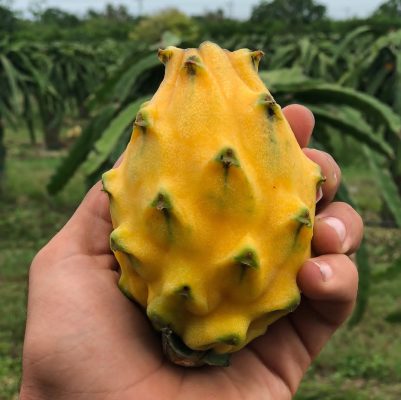 Pin
Pin Photo by miamifruit.org
Yellow dragonfruit breaks the mold that its pink-skinned cousins established, arriving in a sunshine wrapper covered with harder, more pronounced knobs that make it look like it escaped from a different botanical family entirely. The skin peels away more easily than the pink variety, revealing white flesh speckled with tiny black seeds that crunch gently between your teeth. The flavor hits differently too—noticeably sweeter than pink dragonfruit, with a honey-like quality and hints of pear that make it taste more concentrated, more intentional. While pink dragonfruit has become relatively common in upscale grocery stores, yellow dragonfruit remains harder to find, relegated to specialty markets and regions where it grows naturally along the Pacific coasts of Central and South America.
The yellow variety comes from different cactus species than its pink relatives, though they share that overnight blooming habit where spectacular flowers open after dark and wilt by morning. These cacti climb and sprawl across whatever support they find, their succulent stems storing water for dry periods while producing fruits that ripen sporadically throughout the year. Yellow dragonfruit commands higher prices when available because the plants produce smaller yields and the fruits bruise more easily during transport. The skin, while easier to peel, offers less protection than the thicker pink variety, which means more fruit gets damaged between harvest and sale. What keeps yellow dragonfruit special isn’t just its superior sweetness but its relative scarcity, the sense that you’re tasting something most people haven’t encountered yet, a secret that the cactus keeps close to its original home territory.
18. Kadsura
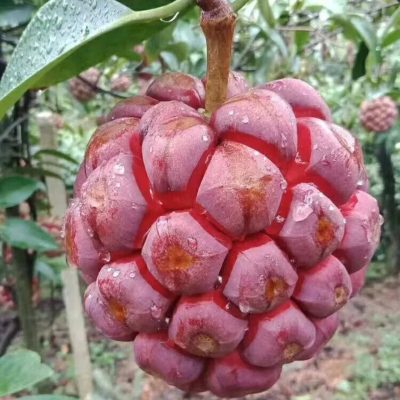 Pin
Pin Photo by Gislene Ha
Kadsura berries dangle from climbing vines in small clusters that look like someone strung together tiny crimson beads on an invisible thread. Each berry measures barely larger than a peppercorn, and the entire fruit cluster rarely exceeds the size of a grape bunch. These vines weave through forests across parts of China, Japan, and Southeast Asia, producing fruits that traditional medicine practitioners have valued for centuries while the culinary world largely ignored them. The berries taste intensely sour with a resinous quality that coats your mouth, not particularly pleasant when eaten raw but interesting when processed. The sourness carries hints of pine and citrus mixed together, a flavor profile that doesn’t invite casual snacking but suggests potential for someone willing to work with it.
Traditional Chinese medicine has incorporated kadsura into various preparations meant to support liver function and boost energy, though the fruits themselves remain obscure even in regions where the vines grow wild. The tiny size makes harvesting labor-intensive for minimal yield, and most people who encounter kadsura vines never realize the berries are edible at all. Some species in the kadsura family produce slightly larger fruits with marginally better flavor, but none have achieved commercial significance. The vines prefer shaded forest conditions and climb high into tree canopies, which puts the fruits literally out of reach for most people. What keeps kadsura in the realm of extreme obscurity is the combination of difficult harvest, challenging flavor, and minuscule size. These are fruits that require specific cultural knowledge and medicinal context to make sense of, existing outside the framework of food as pleasure and firmly in the territory of food as function.
19. Rollinia
 Pin
Pin Photo by Garden Harley
Rollinia sits in the same botanical family as soursop and cherimoya, but it took the custard apple concept and pushed it toward absurdity. The fruit grows lumpy and irregular, covered in soft, fleshy protrusions that give it the appearance of a yellow-green brain or perhaps a hand-knit sweater that went terribly wrong. Each bump yields slightly under pressure when the fruit reaches perfect ripeness, which happens in a narrow window between hard and fermented. Inside, the translucent white flesh surrounds large black seeds in a pattern that requires patience to navigate—you end up eating around the seeds, spitting them out as you work through sections of custard-like pulp. The flavor combines lemon meringue pie with hints of tropical fruit, creamy and sweet with just enough acidity to keep it interesting rather than cloying.
Brazil and other parts of South America grow rollinia in backyard orchards and small farms, but the fruit never achieved the commercial success of its relatives. The flesh oxidizes and ferments almost immediately after the fruit opens, turning from pristine white to brown mush within hours. This rapid deterioration makes shipping rollinia essentially impossible without processing it first, and processing destroys much of what makes the fresh fruit special. The texture, that barely-solid custard consistency, simply doesn’t survive freezing or canning with any grace. People who love rollinia tend to grow their own trees or know someone who does, timing their visits to coincide with the brief harvest season. The fruit demands to be eaten within steps of where it grew, which confines its reputation to those lucky enough to live within its growing range.
20. Red Banana
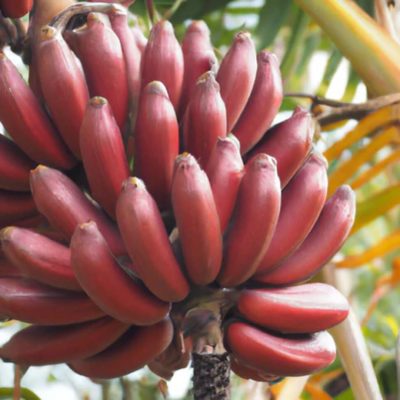 Pin
Pin Photo by Journal of Cesare
Red bananas curve through the produce section like they wandered in from an alternate dimension where someone recolored all the regular fruits just to see what would happen. The skin ripens from deep purple to a dusty maroon, and underneath that unconventional wrapper lies flesh that’s actually cream-colored with just a hint of pink, not the shocking red you might expect from the exterior. The texture feels denser than yellow bananas, almost sticky, and the flavor leans sweeter with undertones of raspberry or strawberry woven through the typical banana taste. Some people detect hints of mango in there too, though whether that’s real or just the power of suggestion working overtime remains debatable. Red bananas grow throughout Southeast Asia, East Africa, and parts of Central America, appearing in markets where vendors arrange them carefully because the skin shows bruises even more dramatically than yellow varieties.
These bananas belong to several different cultivar groups, which means not all red bananas taste identical. Some lean more toward dessert sweetness while others maintain a starchier quality better suited for cooking. The plants themselves look similar to standard banana plants, just producing these unusually pigmented fruits that take slightly longer to ripen and often cost more because they’re less common. What prevents red bananas from dethroning their yellow cousins comes down to shelf life and familiarity. The skin’s dark color makes it harder to judge ripeness at a glance, and they bruise more easily during transport. Most importantly, people see yellow bananas as the default, the standard, which relegates red bananas to novelty status even though they’ve been cultivated for just as long. Breaking through that perception requires more than just good flavor. It requires convincing people that bananas don’t have to be yellow to be real bananas, and that’s a harder sell than you’d think.
FAQs
Some appear occasionally on specialty tropical fruit websites, but most spoil too quickly for reliable shipping. Your best bet is visiting regions where they grow naturally.
Durian wins for dividing people dramatically, but mokambo’s chocolate-citrus combination and rollinia’s custard texture both challenge what you expect fruit to be.
None are toxic, though durian combined with alcohol supposedly causes problems. The main danger is falling durian from trees, which has actually killed people.
Most spoil within hours or days of harvest, bruise easily during transport, or grow too unpredictably for commercial farming to make economic sense.
Many pack serious nutrition—gac fruit’s carotenoids, red palm fruit’s beta-carotene, and soursop’s vitamin C all exceed common fruits by significant margins.






